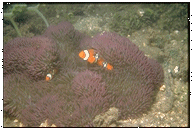
STICHODACTYLA GIGANTEA (FORSSKÄL, 1775)

Gigantic Sea Anemone
Original description As Priapus giganteus, from specimens collected in the Red Sea
Other names previously used include Discosoma giganteum (by Gohar 1948, Schlichter 1968), Stoichactis kenti (by Mariscal 1969, 1970, 1972; Allen 1972, 1973, 1978; Uchida et al. 1975)
Diagnostic field characters Deeply-folded oral disc (more pronounced with size), covered with short (average 10 mm), slightly tapering tentacles that typically all vibrate constantly. Tentacles extremely sticky in life, adhering to collector's hand, and pulling off in clumps; but do not cause stinging sensation. Typically in such shallow water that animals may be exposed at low tide.
Details May be extraordinarily abundant. Oral disc rarely as much as 500 mm diameter, usually lies at surface of sand, often among corals; pedal disc attached to buried object. Non-adhesive verrucae on upper column blue to maroon, contrasting with yellowish, pinkish, tan, greenish-blue, or gray-green column. Basal portion of each tentacle colour of the oral disc (often tan or pink); colour of bluntly pointed distal part -- which is what is generally noted as tentacle colour -- commonly brown or greenish, rarely a striking purple or pink, deep blue, or bright green. Much of central oral disc bare, but deep oral disc folds may hide mouth.
Similar species The shallow, sandy habitat is unusual. Stichodactyla mertensii, which lives on hard substrata, has a flat oral disc and distinctive column. Stichodactyla haddoni typically lives in cleaner sand and deeper water, and its oral disc folds are more regular and more separate than those of S. gigantea; tentacle form and fish symbionts of the two also clearly separate them.
Distribution Micronesia to the Red Sea, and Australia to the Ryukyu Islands
Fish A. akindynos, A. bicinctus, A. clarkii, A. ocellaris, A. percula, A. perideraion, A. rubrocinctus